
STS-89 Biographies
| Wilcutt | Edwards | Dunbar | Anderson | Reilly | Sharipov | Thomas | Wolf |
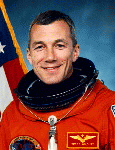 Terrence
W. Wilcutt, Commander
Terrence
W. Wilcutt, Commander
NAME: Terrence W. Wilcutt (Colonel, USMC) NASA Astronaut
PERSONAL DATA: Born October 31, 1949, in Russellville, Kentucky. Enjoys flying, running, weight lifting, woodworking.
EDUCATION: Graduated from Southern High School, Louisville, Kentucky in 1967; received a bachelor of arts degree in math from Western Kentucky University in 1974.
ORGANIZATIONS: Member of Society of Experimental Test Pilots (SETP).
SPECIAL HONORS: Distinguished Flying Cross, Defense Superior Service Medal,Defense Meritorious Service Medal, Pritchard Committee for Academic Excellence, NASA Space Flight Medals (4), Navy Commendation Medal, and Sea Service Deployment Ribbon. Distinguished Graduate of the United States Naval Test Pilot School.
EXPERIENCE: After graduation from college in 1974, Wilcutt taught high school math for two years prior to entering the Marine Corps. He was commissioned in 1976 and earned his wings in 1978. Following initial F-4 Phantom training in VMFAT-101, he reported to VMFA-235, Kaneohe, Hawaii. While assigned to VMFA-235, Wilcutt attended the Naval Fighter Weapons School (Topgun) and made two overseas deployments to Japan, Korea, and the Philippines.
In 1983, he was selected for F/A-18 conversion training and served as an F/A-18 Fighter Weapons and Air Combat Maneuvering Instructor in VFA-125, Lemoore, California. In 1986, Wilcutt was selected to attend the United States Naval Test Pilot School (USNTPS),where he earned the title "Distinguished Graduate." Following graduation from USNTPS he was assigned as a test pilot/project officer for Strike Aircraft Test Directorate (SATD) at the Naval Aircraft Test Center, Patuxent River, Maryland. While assigned to SATD, Wilcutt flew the F/A-18 Hornet, the A-7 Corsair II, the F-4 Phantom, and various other aircraft to test a wide variety of projects and classified programs.
He has over 4,400 flight hours in more than 30 different aircraft.
NASA EXPERIENCE: Selected by NASA in January 1990, Wilcutt became an astronaut in July 1991. Technical assignments to date include: work on Space Shuttle Main Engine and External Tank issues; Astronaut Support Personnel team at the Kennedy Space Center, Florida, supporting Space Shuttle launches and landings; technical issues for the Astronaut Office Operations Development Branch; NASA Director of Operations at the Yuri Gagarin Cosmonaut Training Center, Star City, Russia; Chief of the Astronaut Office Shuttle Operations Branch.
He was the pilot on STS-68 in 1994 and STS-79 in 1996, and was the mission commander on STS-89 in 1998 and STS-106 in 2000. A veteran of four space flights, Wilcutt has logged over 1,007 hours in space.
STS-68 Endeavour (September 30 to October 11, 1994) was part of NASAs Mission to Planet Earth. STS-68, Space Radar Lab-2 (SRL-2), was the second flight of three advanced radars called SIR-C/X-SAR (Spaceborne Imaging Radar-C/X-Band Synthetic Aperture Radar), and a carbon-monoxide pollution sensor, MAPS (Measurement of Air Pollution from Satellites). SIR-C/X-SAR and MAPS operated together in Endeavours cargo bay to study Earths surface and atmosphere, creating radar images of Earths surface environment and mapping global production and transport of carbon monoxide pollution. Real-time crew observations of environmental conditions, along with over 14,000 photographs aided the science team in interpreting the SRL data. The SRL-2 mission was a highly successful test of technology intended for long-term environmental and geological monitoring of planet Earth. STS-68 launched from Kennedy Space Center, Florida, and landed at Edwards Air Force Base, California. Mission duration was 11 days, 5 hours, 46 minutes, traveling 4.7 million miles in 183 orbits of the Earth.
STS-79 Atlantis (September 16-26, 1996), the fourth in the joint American-Russian Shuttle-Mir series of missions, launched from and returned to land at Kennedy Space Center, Florida. STS-79 rendezvoused with the Russian MIR space station and ferried supplies, personnel, and scientific equipment to this base 240 miles above the Earth. The crew transferred over 3.5 tons of supplies to and from the Mir and exchanged U.S. astronauts on Mir for the first time - leaving John Blaha and bringing Shannon Lucid home after her record six months stay aboard Mir. Mission duration was 10 days, 3 hours, 18 minutes, traveling 3.9 million miles in 159 orbits of the Earth.
STS-89 (January 22-31, 1998), was the eighth Shuttle-Mir docking mission during which the crew transferred more than 9,000 pounds of scientific equipment, logistical hardware and water from Space Shuttle Endeavour to Mir. In the fifth and last exchange of a U.S. astronaut, STS-89 delivered Andy Thomas to Mir and returned with David Wolf. Mission duration was 8 days, 19 hours and 47 seconds, traveling 3.6 million miles in 138 orbits of the Earth.
_______________________________________________________________
| Wilcutt | Edwards | Dunbar | Anderson | Reilly | Sharipov | Thomas | Wolf |
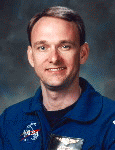 Joe
F. Edwards, Jr., Pilot
Joe
F. Edwards, Jr., Pilot
NAME: Joe Frank Edwards, Jr., (Commander, USN) NASA Astronaut
PERSONAL DATA: Born February 3, 1958, in Richmond, Virginia. Considers Lineville, Alabama, and Roanoke, Alabama, to be his hometowns. Married to the former Janet Leigh Ragan of Leonardtown, Maryland. He enjoys basketball, running, football and softball. His parents, Joe Frank and Jane McMurray Edwards, reside in Roanoke, Alabama.
EDUCATION: Graduated from Lineville High School, Lineville, Alabama, in 1976. Bachelor of Science degree in Aerospace Engineering from the United States Naval Academy, 1980. Master of Science degree in Aviation Systems from University of Tennessee, Knoxville, 1994.
ORGANIZATIONS: Society of Experimental Test Pilots, Association of Naval Aviation, U.S. Naval Institute.
SPECIAL HONORS: Distinguished Flying Cross, Defense Superior Service Medal, Air Medal, Defense Meritorious Service Medal, Navy Commendation Medal, Navy Achievement Medal. Daedalian Superior Airmanship Award 1992, Fighter Squadron 143 Fighter Pilot of the Year, 1984, 1985, Fighter Squadron 142 Fighter Pilot of the Year, 1990, 1991, 1992. Carrier Airwing Seven Pilot of the Year, 1985, 1990, 1991.
EXPERIENCE: Designated a Naval Aviator in February 1982. Assigned to Fighter Squadron 143 in 1983 after completion of F-14 Tomcat training. Flew fighter escort and reconnaissance combat missions over Lebanon in 1983 and graduated from U.S. Navy Fighter Weapons School in 1984. Graduated from U.S. Naval Test Pilot School in 1986 and subsequently worked as project flight test officer and pilot for F-14A(PLUS) and F-14D Full Scale Development. Flew the first Navy flight of the F-14D and a high angle of attack/departure from controlled flight test program for the F-14 airframe/F110 engine integration. Served as Operations and Maintenance Officer in Fighter Squadron 142 1989-1992. Worked as Operations Officer in the Operations Directorate of the Joint Chiefs of Staff, Washington D.C. from 1992-1994. He has flown 4000 hours in over 25 different aircraft and logged over 650 carrier arrested landings.
NASA EXPERIENCE: Selected as an astronaut by NASA in December 1994, Edwards reported to the Johnson Space Center in March 1995. He has worked technical issues for the Space Shuttle and Space Station in the Safety Department of the Astronaut Office, and served as Technical Assistant to the Director, Flight Crew Operations Directorate.
Most recently, Edwards served as pilot on STS-89. In completing his first space flight, Edwards logged over 211 hours in space. He recently completed an assignment as the NASA Director of Operations (DOR), Russia and is currently the Astronaut CAPCOM representative in Mission Control for Shuttle ascent and entry.
STS-89 (January 22-31, 1998), was the eighth Shuttle-Mir docking mission during which the crew transferred more than 9,000 pounds of scientific equipment, logistical hardware and water from Space Shuttle Endeavour to Mir. In the fifth and last exchange of a U.S. astronaut, STS-89 delivered Andy Thomas to Mir and returned with David Wolf. Mission duration was 8 days, 19 hours and 47 seconds, traveling 3.6 million miles in 138 orbits of the Earth.
_______________________________________________________________
| Wilcutt | Edwards | Dunbar | Anderson | Reilly | Sharipov | Thomas | Wolf |
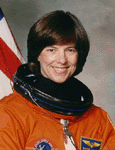 Bonnie
J. Dunbar, Payload Commander
Bonnie
J. Dunbar, Payload Commander
NAME: Bonnie J. Dunbar (Ph.D.) NASA Astronaut
PERSONAL DATA: Born March 3, 1949, in Sunnyside, Washington
EDUCATION: Graduated from Sunnyside High School, Sunnyside, Washington, in 1967; received bachelor of science and master of science degrees in ceramic engineering from the University of Washington in 1971 and 1975, respectively; and a doctorate in Mechanical/Biomedical Engineering from the University of Houston, 1983.
ORGANIZATIONS: Member of the American Ceramic Society (ACS), the National Institute of Ceramic Engineers (NICE), Keramos Honorary, the Society of Biomedical Engineering, American Association for the Advancement of Science, Tau Beta Pi, Materials Research Society (MRS); Board of Directors, Arnold Air Society and Angel Flight, International Academy of Astronautics (IAF), Experimental Aircraft Association (EAA), Society of Women Engineers (SWE), Association of Space Explorers (ASE).
SPECIAL HONORS: American Ceramics Society James I. Mueller Award, Cocoa Beach, Florida. (2000). Inducted into the Women in Technology International (WITI) Hall of Fame in 2000, one of five women in the world so honored. Selected as one of the top 20 women in technology in Houston, Texas (2000). NASA Space Flight Medals (1985, 1990, 1992, 1995 and 1998). Superior Accomplishment Award (1997). Member, National Science Foundation (NSF) Engineering Advisory Board, 1993 - present. NASA Exceptional Achievement Medal(1996). NASA Outstanding Leadership Award (1993). Fellow of American Ceramic Society (1993). Design News Engineering Achievement Award (1993). IEEE Judith Resnik Award (1993). Society of Women Engineers Resnik Challenger Medal (1993). Boeing Corporation Pathfinder Award (1992). AAES National Engineering Award (1992). NASA Exceptional Service Award (1991). University of Houston Distinguished Engineering Alumna (1991). M.R.S. Presidents Award (1990). ACS Schwaltzwalder P.A.C.E. Award (1990). University of Washington Engineering Alumni Achievement (1989). NASA Exceptional Service Medal (1988). ACS Life Membership (1986). General Jimmy Doolittle Fellow of the Aerospace Education Foundation (1986). Evergreen Safety Council Public Service in Space Award (1986). American Ceramic Society (ACS) Greaves-Walker Award (1985). Rockwell International Engineer of the Year in 1978. Graduated Cum Laude from the University of Washington in 1975.
EXPERIENCE: Following graduation in 1971, Dr. Dunbar worked for Boeing Computer Services for two years as a systems analyst. From 1973 to 1975, she conducted research for her masters thesis in the field of mechanisms and kinetics of ionic diffusion in sodium beta-alumina.
In 1975, she was invited to participate in research at Harwell Laboratories in Oxford, England, as a visiting scientist. Her work there involved the wetting behavior of liquids on solid substrates. Following her work in England, she accepted a senior research engineer position with Rockwell International Space Division in Downey, California. Her responsibilities there included developing equipment and processes for the manufacture of the Space Shuttle thermal protection system in Palmdale, California. She also represented Rockwell International as a member of the Dr. Kraft Ehricke evaluation committee on prospective space industrialization concepts.
Dr. Dunbar completed her doctorate at the University of Houston in Houston, Texas. Her multi-disciplinary dissertation (materials science and physiology) involved evaluating the effects of simulated space flight on bone strength and fracture toughness. These results were correlated to alterations in hormonal and metabolic activity. Dr. Dunbar has served as an adjunct assistant professor in Mechanical Engineering at the University of Houston.
She is a private pilot with over 200 hours in single engine land aircraft, has logged more than 700 hours flying time in T-38 jets as co-pilot, and has over 100 hours as co-pilot in a Cessna Citation Jet.
NASA EXPERIENCE: Dr. Dunbar accepted a position as a payload officer/flight controller at the Lyndon B. Johnson Space Center in 1978. She served as a guidance and navigation officer/flight controller for the Skylab reentry mission in 1979 and was subsequently designated project officer/payload officer for the integration of several Space Shuttle payloads.
Dr. Dunbar became a NASA astronaut in August 1981. Her technical assignments have included assisting in the verification of Shuttle flight software at the Shuttle Avionics Integration Laboratory (SAIL), serving as a member of the Flight Crew Equipment Control Board, participation as a member of the Astronaut Office Science Support Group, supporting operational development of the remote manipulator system (RMS). She has served as chief of the Mission Development Branch, as the Astronaut Office interface for "secondary" payloads, and as lead for the Science Support Group.
In 1993, Dr. Dunbar served as Deputy Associate Administrator, Office of Life and Microgravity Sciences, NASA Headquarters, Washington, D.C. In February 1994, she traveled to Star City, Russia, where she spent 13-months training as a back-up crew member for a 3-month flight on the Russian Space Station, Mir. In March 1995, she was certified by the Russian Gagarin Cosmonaut Training Center as qualified to fly on long duration Mir Space Station flights.
From October 1995 to November 1996, she was detailed to the NASA JSC Mission Operations Directorate as Assistant Director where she was responsible for chairing the International Space Station Training Readiness Reviews, and facilitating Russian/American operations and training strategies. Currently, Dr. Dunbar serves as Assistant Director to the NASA Johnson Space Center (JSC) with a focus on University Research.
A veteran of five space flights, Dr. Dunbar has logged more than 1,208 hours (50 days) in space. She served as a mission specialist on STS 61-A in 1985, STS-32 in 1990, and STS-71 in 1995, and was the Payload Commander on STS-50 in 1992, and STS-89 in 1998.
STS 61-A Challenger (October 30-November 6, 1985), was the West German D-1 Spacelab mission. It was the first to carry eight crew members, the largest to fly in space, and was also the first in which payload activities were controlled from outside the United States. More than 75 scientific experiments were completed in the areas of physiological sciences, materials science, biology, and navigation. During the flight, Dr. Dunbar was responsible for operating Spacelab and its subsystems and performing a variety of experiments. Her mission training included six months of experiment training in Germany, France, Switzerland, and The Netherlands. STS 61-A launched from the Kennedy Space Center, Florida, and returned to land at Edwards Air Force Base, California. Mission duration was 7 days, 44 minutes 51 seconds, traveling 2.5 million miles in 111 orbits of the Earth.
STS-32 Columbia (January 9-20, 1990), launched from the Kennedy Space Center, Florida, and returned to a night landing at Edwards Air Base in California. During the flight, the crew successfully deployed the Syncom IV-F5 satellite, and retrieved the 21,400-pound Long Duration Exposure Facility (LDEF) using the RMS. They also operated a variety of middeck experiments including the Microgravity Disturbance Experiment (MDE) using the Fluids Experiment Apparatus (FEA), Protein Crystal Growth (PCG), American Flight Echocardiograph (AFE), Latitude/Longitude Locator (L3), Mesoscale Lightning Experiment (MLE), Characterization of Neurospora Circadian Rhythms (CNCR),and the IMAX Camera. Dr. Dunbar was principal investigator for the MDE/FEA Experiment. Additionally, numerous medical test objectives, including in-flight lower body negative pressure (LBNP), in-flight aerobic exercise and muscle performance were conducted to evaluate human adaptation to extended duration missions. Mission duration was 10 days, 21 hours, 01 minute, 38 seconds, traveling 4.5 million miles in 173 orbits of the Earth.
STS-50 Columbia (June 25 to July 9, 1992). Dr. Dunbar was the Payload Commander on STS-50, the United States Microgravity Lab-1 mission which was dedicated to microgravity fluid physics and materials science. Over 30 experiments sponsored by over 100 investigators were housed in the Spacelab in the Shuttles Payload Bay. A payload crew of four operated around-the-clock for 13 days performing experiments in scientific disciplines such as protein crystal growth, electronic and infrared detector crystal growth, surface tension physics, zeolite crystal growth, and human physiology. Mission duration was 13 days, 19 hours, 30 minutes and 4 seconds, traveling 5.7 million miles in 221 orbits of the Earth.
STS-71 Atlantis (June 27 to July 7, 1995), was the first Space Shuttle mission to dock with the Russian Space Station Mir, and involved an exchange of crews. The Atlantis was modified to carry a docking system compatible with the Russian Mir Space Station. Dr. Dunbar served as MS-3 on this flight which also carried a Spacelab module in the payload bay in which the crew performed medical evaluations on the returning Mir crew. These evaluations included ascertaining the effects of weightlessness on the cardio/vascular system, the bone/muscle system, the immune system, and the cardio/pulmonary system. Mission duration was 9 days, 19 hours, 23 minutes and 8 seconds, traveling 4.1 million miles in 153 orbits of the Earth.
STS-89 Endeavour (January 22-31, 1998), was the eighth Shuttle-Mir docking mission during which the crew transferred more than 9,000 pounds of scientific equipment, logistical hardware and water from Space Shuttle Endeavour to Mir. In the fifth and last exchange of a U.S. astronaut, STS-89 delivered Andy Thomas to Mir and returned with David Wolf. Mission duration was 8 days, 19 hours and 47 seconds, traveling 3.6 million miles in 138 orbits of the Earth. Dr. Dunbar was the Payload Commander, responsible for all payload activities including the conduct of 23 technology and science experiments.
_______________________________________________________________
| Wilcutt | Edwards | Dunbar | Anderson | Reilly | Sharipov | Thomas | Wolf |
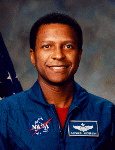 Michael
P. Anderson, Mission Specialist
Michael
P. Anderson, Mission Specialist
NAME: Michael P. Anderson (Lieutenant Colonel, USAF) NASA Astronaut
PERSONAL DATA: Born December 25, 1959, in Plattsburgh, New York. Considers Spokane, Washington, to be his hometown. Married. Enjoys photography, chess, computers, and tennis.
EDUCATION: Graduated from Cheney High School in Cheney, Washington, in 1977. Bachelor of science degree in physics/astronomy from University of Washington, 1981. Master of science degree in physics from Creighton University, 1990.
SPECIAL HONORS: Distinguished graduate USAF Communication Electronics Officers course. Recipient of the Armed Forces Communication Electronics Associations Academic Excellence Award 1983. Received the USAF Undergraduate Pilot Training Academic Achievement Award for Class 87-08 Vance AFB. Awarded the Defense Superior Service Medal, the USAF Meritorious Service Medal, and the USAF Achievement Medal with one oak leaf cluster.
EXPERIENCE: Anderson graduated form the University of Washington in 1981 and was commissioned a second lieutenant. After completing a year of technical training at Keesler AFB Mississippi he was assigned to Randolph AFB Texas.
At Randolph he served as Chief of Communication Maintenance for the 2015 Communication Squadron and later as Director of Information System Maintenance for the 1920 Information System Group. In 1986 he was selected to attend Undergraduate Pilot Training at Vance AFB, Oklahoma.
Upon graduation he was assigned to the 2nd Airborne Command and Control Squadron, Offutt AFB Nebraska as an EC 135 pilot, flying the Strategic Air Commands airborne command post code-named "Looking Glass". From January 1991 to September 1992 he served as an aircraft commander and instructor pilot in the 920th Air Refueling Squadron, Wurtsmith AFB Michigan. From September 1992 to February 1995 he was assigned as an instructor pilot and tactics officer in the 380 Air Refueling Wing, Plattsburgh AFB New York.
Anderson has logged over 3000 hours in various models of the KC-135 and the T-38A aircraft.
NASA EXPERIENCE: Selected by NASA in December 1994, Anderson reported to the Johnson Space Center in March 1995. He completed a year of training and evaluation, and is qualified for flight crew assignment as a mission specialist. Anderson was initially assigned technical duties in the Flight Support Branch of the Astronaut Office.
Most recently, he flew on the crew of STS-89. In completing his first space flight Anderson has logged over 211 hours in space. Anderson is assigned to the crew of STS-107 scheduled to launch in 2001.
STS-89 (January 22-31, 1998), was the eighth Shuttle-Mir docking mission during which the crew transferred more than 9,000 pounds of scientific equipment, logistical hardware and water from Space Shuttle Endeavour to Mir. In the fifth and last exchange of a U.S. astronaut, STS-89 delivered Andy Thomas to Mir and returned with David Wolf. Mission duration was 8 days, 19 hours and 47 seconds, traveling 3.6 million miles in 138 orbits of the Earth.
_______________________________________________________________
| Wilcutt | Edwards | Dunbar | Anderson | Reilly | Sharipov | Thomas | Wolf |
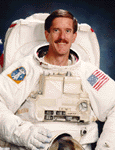 James
F. Reilly, II, Mission Specialist
James
F. Reilly, II, Mission Specialist
NAME: James F. Reilly, II (Ph.D.) NASA Astronaut
PERSONAL DATA: Born March 18, 1954, Mountain Home Air Force Base, Idaho. Considers Mesquite, Texas, to be his hometown. Married to the former Jo Ann Strange, a native of Dallas, Texas. Three children. He enjoys flying, skiing, photography, running, soccer, hunting and fishing. His father, James F. Reilly, resides in Rockwall, Texas. His mother, Billie N. Ruether, resides in Tyler, Texas. Her parents, Robert and Mildred Strange, reside in Dallas, Texas.
EDUCATION: Graduated from Lake Highlands High School, Dallas Texas, in 1972. Bachelor of science degree in geosciences from University of Texas-Dallas, 1977. Master of science degree in geosciences from University of Texas-Dallas, 1987. Doctorate in geosciences from University of Texas-Dallas, in 1995.
ORGANIZATIONS: Member of the American Association of Petroleum Geologists, Aircraft Owners and Pilots Association, American Institute of Aeronautics and Astronautics.
SPECIAL HONORS: Awarded the Antarctic Service Medal, 1978. US Navy ROTC scholarship, 1972.
EXPERIENCE: After receiving his Bachelor of Science degree in 1977, Reilly entered graduate school and was selected to participate as a research scientist specializing in stable isotope geochronology as part of the 1977-1978 scientific expedition to Marie Byrd Land, West Antarctica.
In 1979, he accepted employment as an exploration geologist with Santa Fe Minerals Inc., in Dallas, Texas. From 1980 to the time he was selected for the astronaut program, Reilly was employed as an oil and gas exploration geologist for Enserch Exploration Inc., in Dallas, Texas, rising to the position of Chief Geologist of the Offshore Region.
Concurrent with his duties as an exploration geologist, he was actively involved in the application of new imaging technology for industrial applications in deep water engineering projects and biological research. As part of this work, Reilly has spent approximately 22 days in deep submergence vehicles operated by Harbor Branch Oceanographic Institution and the US Navy.
NASA EXPERIENCE: Selected by NASA in December 1994, Reilly reported to the Johnson Space Center in March 1995, has completed a year of training and evaluation, and is qualified for flight assignment as a mission specialist. He was initially assigned to work technical issues for the Astronaut Office Computer Support Branch. He flew on STS-89 and has logged over 211 hours in space. Reilly is assigned to STS-104 where he is scheduled to peform three spacewalks related to the assembly of the International Space Station (ISS). Launch is targeted for 2001.
STS-89 (January 22-31, 1998), was the eighth Shuttle-Mir docking mission during which the crew transferred more than 9,000 pounds of scientific equipment, logistical hardware and water from Space Shuttle Endeavour to Mir. In the fifth and last exchange of a U.S. astronaut, STS-89 delivered Andy Thomas to Mir and returned with David Wolf. Mission duration was 8 days, 19 hours and 47 seconds, traveling 3.6 million miles in 138 orbits of the Earth.
_______________________________________________________________
| Wilcutt | Edwards | Dunbar | Anderson | Reilly | Sharipov | Thomas | Wolf |
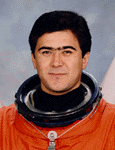 Salizhan
S. Sharipov, GCTC, Mission Specialist
Salizhan
S. Sharipov, GCTC, Mission Specialist
NAME: Salizhan Shakirovich Sharipov GCTC Cosmonaut
PERSONAL DATA: Born August 24, 1964 in Uzgen, Oshsk region, Kirghizia. Married to Nadezhda Mavlyanovna Sharipova. They have one daughter and one son. He enjoys football, likes to read books. His father, Mr. Shakirzhan Sharipov, resides in Uzgen, Oshsk region, Kirghizia.
EDUCATION: Graduated from the Air Force Pilot School in 1987. In 1994, he graduated from Moscow State University with a degree in cartography.
EXPERIENCE: After graduation from the Air Force Pilot School in 1987, he worked as a pilot-instructor and taught 8 cadets. He has logged over 950 hours flying time. He has experience flying on MIG-21, L-39 aircraft.
Selected by the Gagarin Cosmonaut Training Center (GCTC) Sharipov became a cosmonaut-candidate in 1990. In 1992, he completed general space training and became a cosmonaut. As a member of the group he has completed a full course of training for OC MIR space flights as a crew commander.
Sharipov has flown one mission and has logged over 211 hours in space. He served as a mission specialist on the crew of STS-89 (January 22-31, 1998), the eighth Shuttle-Mir docking mission during which the crew transferred more than 8,000 pounds of scientific equipment, logistical hardware and water from Space Shuttle Endeavour to Mir. In the fifth and last exchange of a U.S. astronaut, STS-89 delivered Andy Thomas to Mir and returned with David Wolf. Mission duration was 8 days, 19 hours and 47 seconds, traveling 3.6 million miles in 138 orbits of the Earth.
_______________________________________________________________
| Wilcutt | Edwards | Dunbar | Anderson | Reilly | Sharipov | Thomas | Wolf |
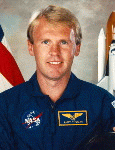 Andrew
S. W. Thomas, NASA-7 Mir Resident
Andrew
S. W. Thomas, NASA-7 Mir Resident
NAME: Andrew S. W. Thomas (Ph.D.) NASA Astronaut
PERSONAL DATA: Born December 18, 1951, in Adelaide, South Australia. Single. He enjoys horse riding and jumping, mountain biking, running, wind surfing, and classical guitar playing. His father, Adrian C. Thomas, resides in Hackham, South Australia. His mother, Mary E. Thomas, resides in North Adelaide, South Australia.
EDUCATION: Received a bachelor of engineering degree in mechanical engineering, with First Class Honors, from the University of Adelaide, South Australia, in 1973, and a doctorate in mechanical engineering from the University of Adelaide, South Australia, in 1978.
ORGANIZATIONS: Member of the American Institute of Aeronautics and Astronautics.
EXPERIENCE: Dr. Thomas began his professional career as a research scientist with the Lockheed Aeronautical Systems Company, Marietta, Georgia, in 1977. At that time he was responsible for experimental investigations into the control of fluid dynamic instabilities and aircraft drag. In 1980, he was appointed Principal Aerodynamic Scientist to the company and headed a research team examining various problems in advanced aerodynamics and aircraft flight test.
This was followed in 1983 by an appointment as the head of the Advanced Flight Sciences Department to lead a research department of engineers and scientists engaged in experimental and computational studies in fluid dynamics, aerodynamics and aeroacoustics. He was also manager of the research laboratory, the wind tunnels, and the test facilities used in these studies.
In 1987, Dr. Thomas was named manager of Lockheed's Flight Sciences Division and directed the technical efforts in vehicle aerodynamics, flight controls and propulsion systems that supported the company's fleet of production aircraft. In 1989, he moved to Pasadena, California, to join the Jet Propulsion Laboratory (JPL) and, shortly after, was appointed leader of the JPL program for microgravity materials processing in space. This NASA-sponsored research included scientific investigations, conducted in the laboratory and in low gravity on NASA's KC-135 aircraft, as well as technology studies to support the development of the space flight hardware for future Shuttle missions.
NASA EXPERIENCE: Dr. Thomas was selected by NASA in March 1992 and reported to the Johnson Space Center in August 1992. In August 1993, following one year of training, he was appointed a member of the astronaut corp and was qualified for assignment as a mission specialist on Space Shuttle flight crews. While awaiting space flight assignment, Dr. Thomas supported Shuttle launch and landing operations as an Astronaut Support Person (ASP) at the Kennedy Space Center. He also provided technical support to the Space Shuttle Main Engine project, the Solid Rocket Motor project and the External Tank project at the Marshall Space Flight Center.
In June 1995, Dr. Thomas was named as payload commander for STS-77 and flew his first flight in space on Endeavour in May 1996. He next trained at the Gagarin Cosmonaut Training Center in Star City, Russia in preparation for a long-duration flight. In 1998, he served as Board Engineer 2 aboard the Russian Space Station Mir for 130 days. He is in training for the STS-102 mission, targeted for launch in 2000.
STS-77 was a 10-day mission during which the crew deployed two satellites, tested a large inflatable space structure on orbit and conducted a variety of scientific experiments in a Spacehab laboratory module carried in Endeavour's payload bay. The flight was launched from the Kennedy Space Center on May 19, 1996 and completed 160 orbits 153 nautical miles above the Earth while traveling 4.1 million miles and logging 240 hours and 39 minutes in space.
On January 22, 1998, Dr. Thomas launched aboard Space Shuttle Endeavour as part of the STS-89 crew to dock with the Mir Space Station. He served aboard Mir as Flight Engineer 2 and returned to Earth with the crew of STS-91 aboard Space Shuttle Discovery on June 12, 1998, completing 141 days in space and 2,250 orbits of the Earth.
_______________________________________________________________
| Wilcutt | Edwards | Dunbar | Anderson | Reilly | Sharipov | Thomas | Wolf |
 David
A. Wolf, NASA-6 Mir Resident
David
A. Wolf, NASA-6 Mir Resident
NAME: David A. Wolf (M.D.) NASA Astronaut
PERSONAL DATA: Born August 23, 1956, in Indianapolis, Indiana. Single. He enjoys sport aerobatic flying, scuba diving, handball, running, and water skiing. His parents, Dr. and Mrs. Harry Wolf, reside in Indianapolis.
EDUCATION: Graduated from North Central High School, Indianapolis, Indiana, in 1974; received a bachelor of science degree in electrical engineering from Purdue University in 1978, and a doctorate of medicine from Indiana University in 1982. He completed his medical internship (1983) at Methodist Hospital in Indianapolis, Indiana, and USAF flight surgeon primary training at Brooks Air Force Base in San Antonio, Texas.
ORGANIZATIONS: Member of the Institute of Electrical and Electronics Engineers; the Aerospace Medical Association; the Experimental Aircraft Association; the International Aerobatic Club; and the Air National Guard.
SPECIAL HONORS: Recipient of the NASA Exceptional Engineering Achievement Medal (1990); NASA Inventor of the Year, 1992. Dr. Wolf graduated "with distinction" from the honors curriculum in electrical engineering at Purdue University and received an Academic Achievement Award upon graduation from medical school. He received the Carl R. Ruddell scholarship award for research in medical ultrasonic signal and image processing. He is a member of Eta Kappa Knu and Phi Eta Sigma honorary societies. Dr. Wolf has received 11 U.S. Patents and over 20 Space Act Awards for 3-dimensional tissue engineering technologies earning the Texas State Bar Patent of the Year in 1994. He has published over 40 technical papers.
EXPERIENCE: As a research scientist at the Indianapolis Center for Advanced Research from 1980 to 1983, he developed digital signal and image processing techniques utilizing matched filter detection of high time-bandwidth product transmissions producing "state of the art" high resolution medical ultrasonic images to the 100 micron level. He also developed new doppler demodulation techniques extending the range velocity product limitation of conventional pulsed doppler systems.
He is a USAF senior flight surgeon in the Air National Guard (1982 to present) and is a member of the Board of Directors of the National Inventors Hall of Fame. He has logged over 2000 hours of flight time including air combat training as a weapons systems officer (F4 Phantom jet), T-38 Talon, and competition aerobatics (PITTS Special and Christen Eagle).
NASA EXPERIENCE: : In 1983, Dr. Wolf joined the Medical Sciences Division, Johnson Space Center, Houston, Texas. He was responsible for development of the American Flight Echocardiograph for investigating cardiovascular physiology in microgravity. Upon completion he was assigned as chief engineer for design of the Space Station medical facility.
In 1986 he was assigned to direct development of the Space Bioreactor and associated tissue engineering and cancer research applications utilizing controlled gravitational conditions. This resulted in the state of the art NASA rotating tissue culture systems. He has particular expertise in the design of real time computer process control systems, communications, bioprocessing, physiology, fluid dynamics, and aerospace medicine.
Dr. Wolf is an active public speaker. Selected as a NASA astronaut in January 1990, Dr. Wolf became qualified for space flight in July 1991. His technical assignments have included Orbiter vehicle processing and test at Kennedy Space Center (1991-1992) and spacecraft communications (CAPCOM) (1994-1995). He is qualified for Extravehicular Activity (Spacewalk), Remote Manipulator System (Robot Arm), and Rendezvous.
He was CAPCOM for the first and third Shuttle-Mir rendezvous. He trained at the Gagarin Cosmonaut Training Center in Star City, Russia, in preparation for a long-duration stay aboard Mir. Dr. Wolf has logged 142 days in space including a 4 hour EVA in a Russian Orlan spacesuit. He was a mission specialist on STS-58, and served as Board Engineer 2 for 119 days aboard the Russian Space Station Mir. He is currently assigned to the EVA Development Group focusing on assembly techniques for the International Space Station.
STS-58 Columbia (10/16/93-11/1/93) was a 14-day dedicated Spacelab life sciences research mission. During this record length Shuttle mission the crew conducted neurovestibular, cardiovascular, cardiopulmonary, metabolic, and musculoskeletal research utilizing microgravity to reveal fundamental physiology normally masked by Earth gravity. Mission duration was 336 hours, 13 minutes, 01 seconds.
On September 25, 1997, Dr. Wolf launched aboard Space Shuttle Atlantis as part of the STS-86 crew. Following docking, September 28, 1997 marked the official start of his 119 days aboard Mir. He returned with the crew of STS-89 aboard Shuttle Endeavour on January 31, 1998. Mission duration was 128 days.